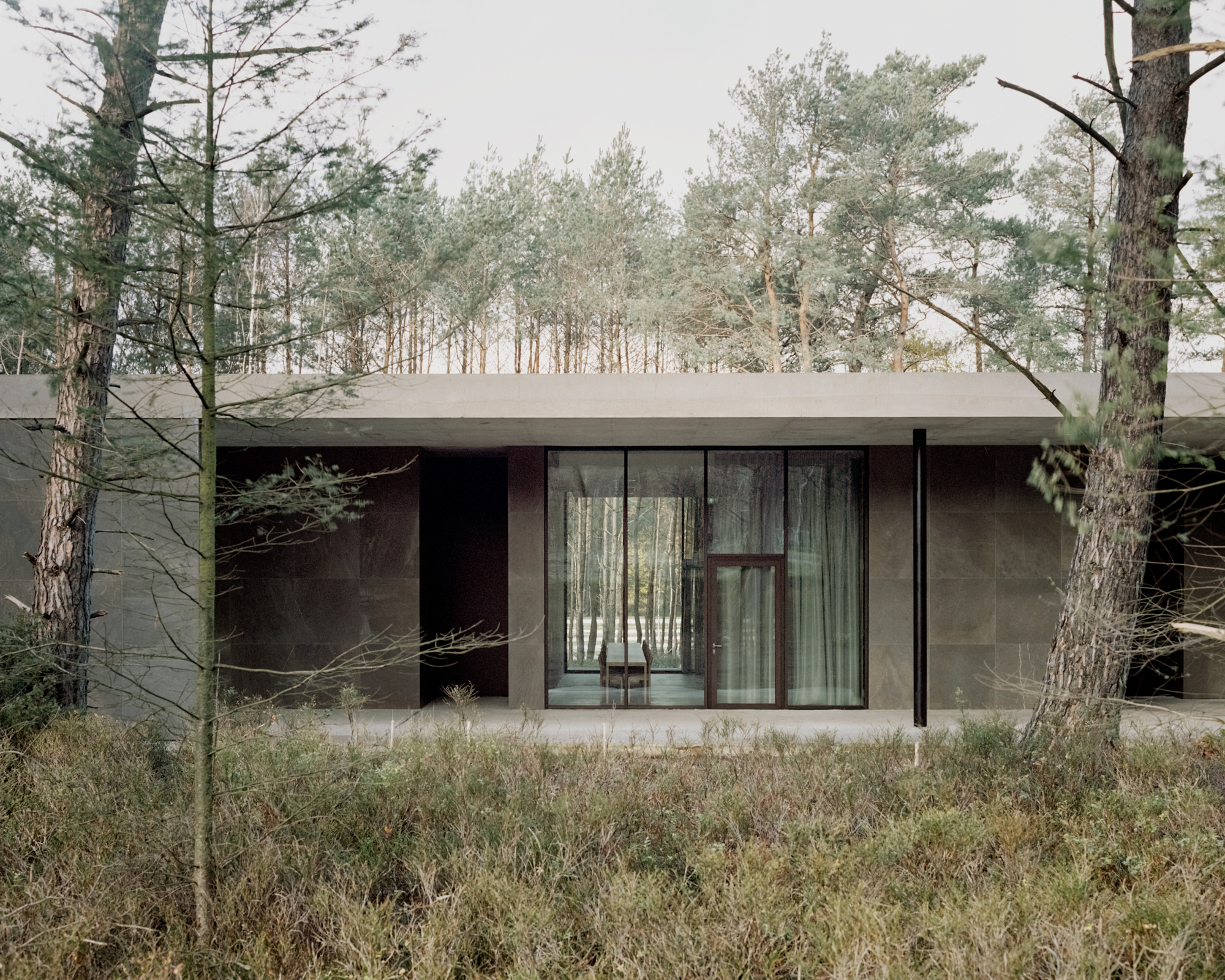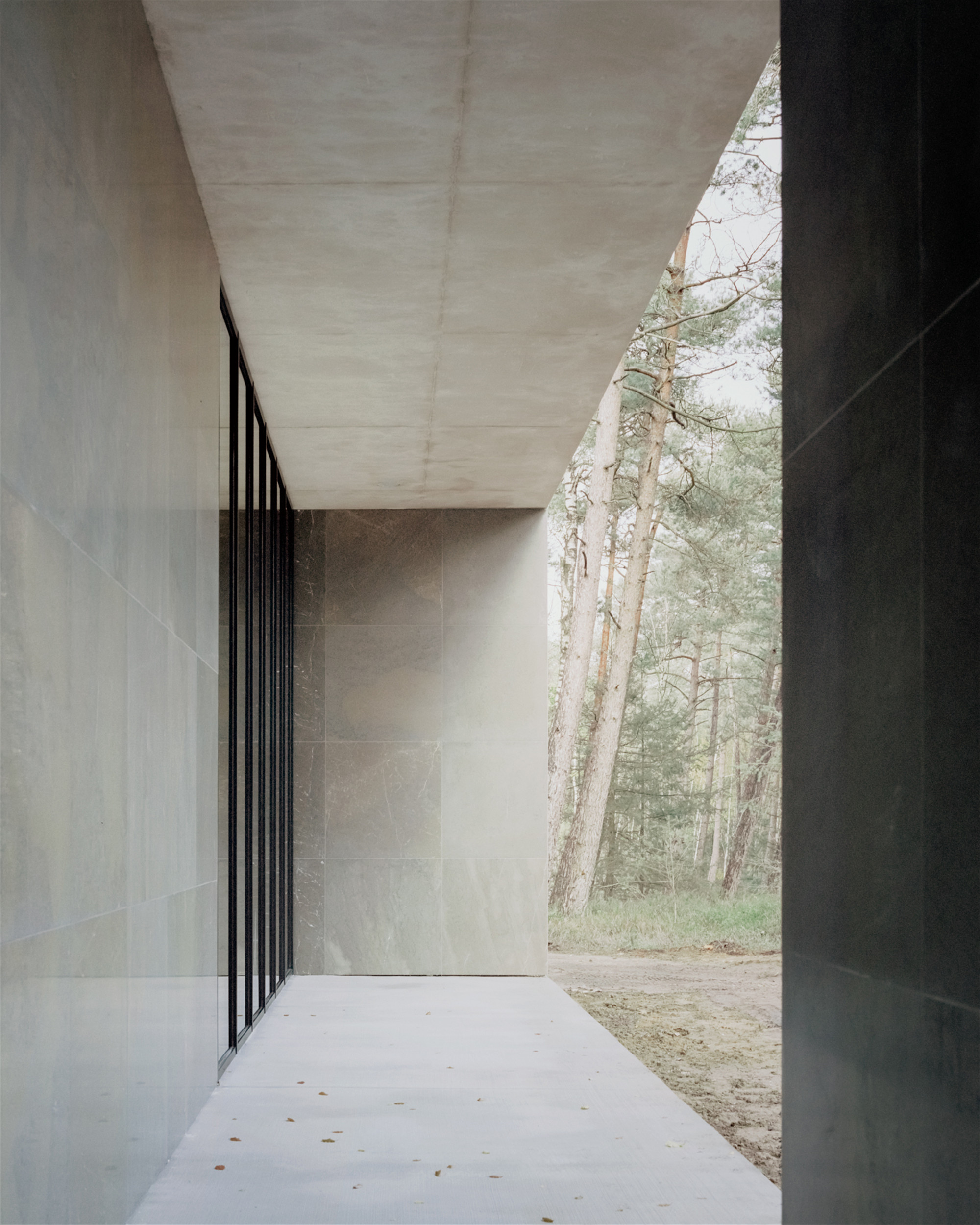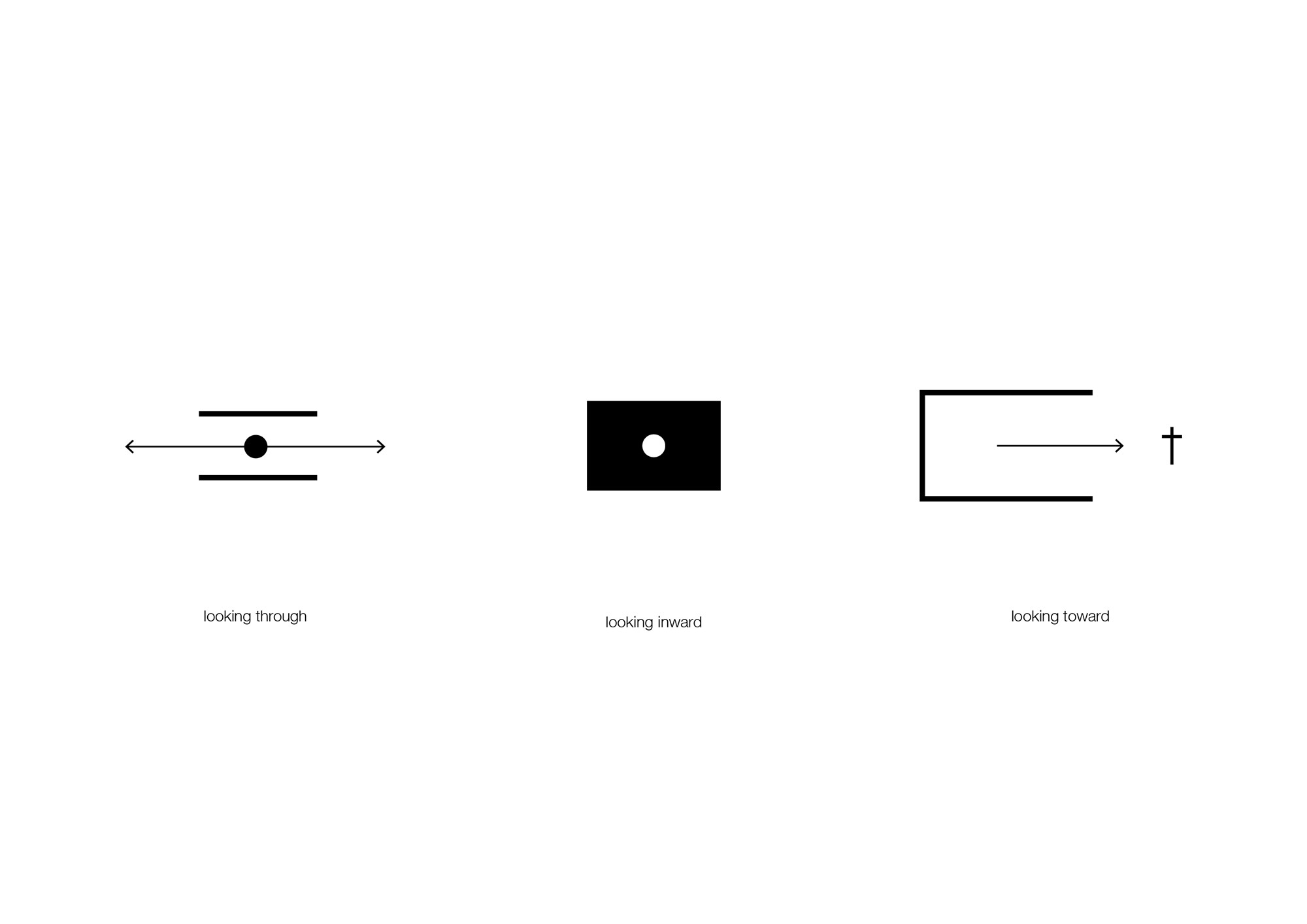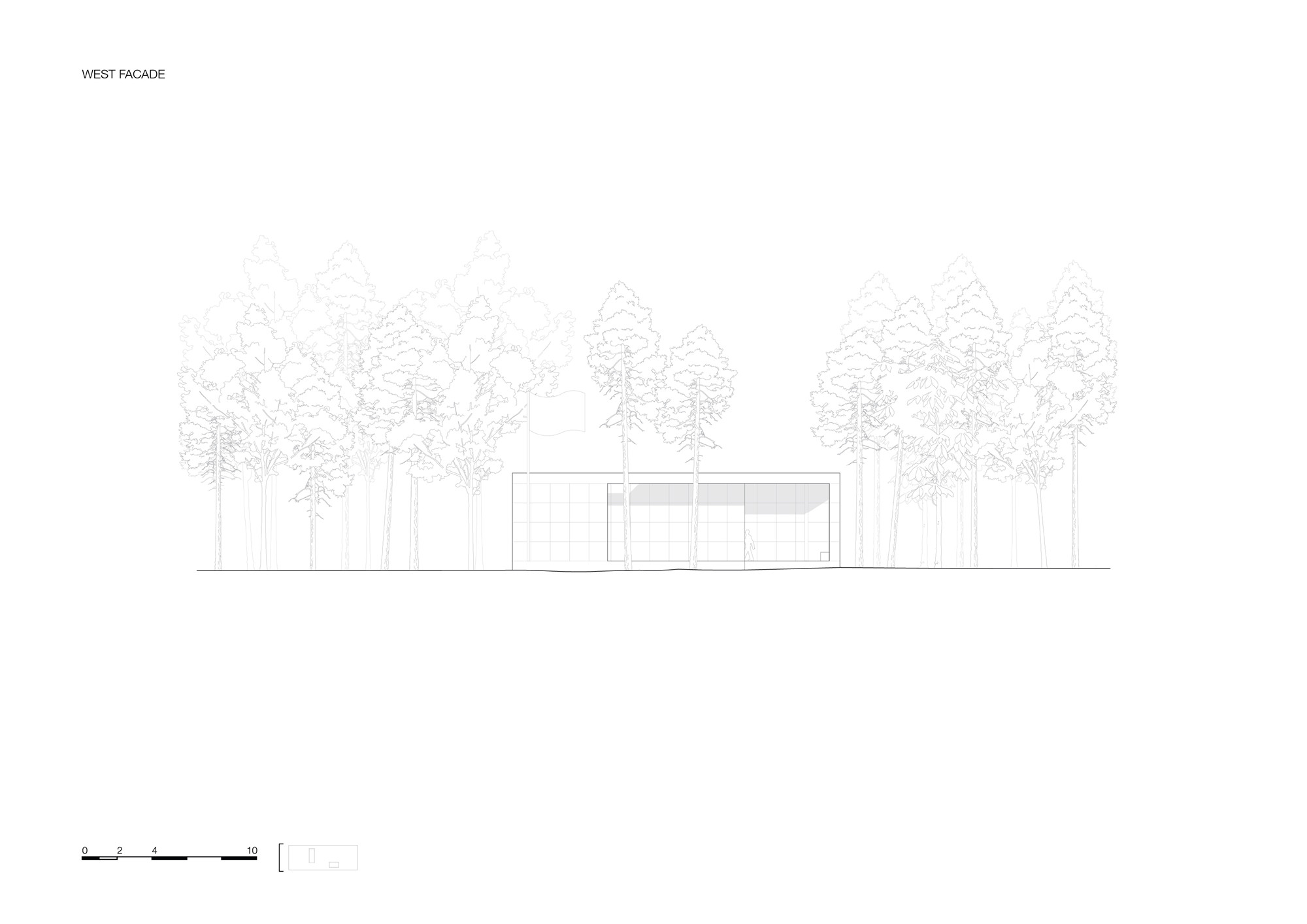
设计单位 KAAN Architecten
项目地点 荷兰卢恩
建成时间 2020年11月
建筑面积 583平方米
事务所受荷兰战亡者基金会(Oorlogsgravenstichting)的委托,在阿珀尔多伦附近的卢恩(Loenen)设计了一座多功能建筑,以此纪念在“二战”和近期国际冲突中遇害的荷兰人。该建筑与周围的森林和谐地融为一体,在现有的卢恩国家战争公墓和新建的国家退伍军人公墓之间既起到了区分又做到了联系。
KAAN Architecten was commissioned by the Netherlands War Graves Foundation (Oorlogsgravenstichting) to design a multifunctional building commemorating the Dutch victims during the Second World War and more recent international conflicts, in Loenen near Apeldoorn. Harmoniously blending with the surrounding forest, the building is a layered and connecting element between the existing Loenen National War Cemetery and the new National Veterans Cemetery.



卢恩国家战争公墓由景观建筑师Daniel Haspels在“二战”后不久进行设计,一簇簇纤细的树木反映了该地区的景观,(设计)向和平表示以敬意,为逝者家属带来慰藉。设计师选择将树木和建筑放置在一起,让树木决定构造的形式,以实现建筑和景观自然的融合。
The Loenen National War Cemetery site was designed by landscape architect Daniel Haspels (1894-1954) shortly after the Second World War, reflecting the landscape of the area with its clusters of wispy trees that honour the peaceful environment and bring comfort to the bereaved. KAAN Architecten opted to draw the trees and building together, letting the trees dictate the structure’s form, to achieve a fusion of architecture and landscaped nature.




纪念亭占地尺寸为52×19米,沿着纪念馆中五条关键轴线中的其中一条延伸,就像在纤细高耸的树木间勾勒出一道白线。俯瞰建筑,它位于景观设计团队Karres en Brands设计两片树林之间。纪念亭尽可能地缩小体量,以最大限度地保留两片开放场域上的树木,其水平体量也是遵从了Daniel Haspels的理念,避免垂直元素的使用对周围宁静氛围带来的破坏,就这样安静地栖息在草坪上。
The pavilion, with its 52 x 19-meter footprint, stretches along one of the five axes that are the foundation of the site, like a horizontal white line settled amidst slender birch and pine trees. Seen from above, it is situated between two stretches of woods, flanked by two forest rooms envisioned by landscape architects Karres en Brands. The pavilion was kept as narrow as possible to preserve a maximum number of trees between the two open spaces, its horizontality gently adopts Haspels’ philosophy by avoiding vertical elements, which could disrupt the calming natural atmosphere. For this reason, the War Cemetery’s gravestones are lying flat on the grass.



建筑兼具了开放性和私密感,以敏锐的姿态迎合了宁静的氛围,减少了对场地的干扰。建筑地处层层树干之间,却依然保持了清晰的视野。天然石砌墙从地面延伸至天花,凸显出开放与封闭间的交替感。一些墙壁上的长椅和石墙融为一体,面向树林,为游客提供休息和冥思的场所。屋面不仅是提供遮蔽的顶盖,而是一个留有洞口的水平墙面,露出树梢和开阔的天空。通过巧妙的视线引导,设计团队保留了国家战争公墓中的宁静氛围和光芒。
The serene atmosphere and lack of intrusiveness have been achieved by sensitive architectural gestures, proposing an intimate yet open and inviting building; obscured by tree trunks yet in clear view. Strategically placed, natural stone-clad walls stretching from floor to ceiling accentuate the alternation between open and closed. Some walls have benches protruding in the same natural stone as the wall and facing the forest to offer visitors places to rest and contemplate. Atop the walls lies the roof - not merely as a cover for a box, but a horizontal wall with perforations that expose the treetops and open skies. By masterfully directing the sightlines inward, outward, and through, KAAN Architecten maintained the fragile aura of light and tranquillity already imbued in the National War Cemetery.




馆内空间内的一切都与纪念性有关。馆内避免了交通空间,所以可以保持狭长的体量,各功能之间可以顺理成章地相互流动。馆内设有一个礼堂,专用于附近的国家退伍军人公墓的集会和殡葬服务,打开礼堂后有一个多功能厅,这里兼用于展厅和资料室,空间的最后则是吊唁区。在举办活动和大型仪式时,礼堂和展览空间可以合并为一个没有阻碍的大厅。
Everything within the space of the pavilion is related to remembrance and commemoration. Corridors were avoided so the pavilion could remain narrow and functions flow logically into one another. There is an auditorium dedicated to assemblies and funeral services for the nearby National Veterans Cemetery, opening up to a multi-purpose room serving both as exhibition and information space and finally a condolences area. For events and large-scale ceremonies, the auditorium and exhibition space can be merged into a single hall, free of obstacles.




每个空间都有各自的特色和亮点,吊唁区朝向两侧的树林,分别面向两处公墓。与此同时,从礼堂远眺,目光停驻于战争公墓中间的十字架,视线穿过巨大的窗户,它就像展馆的一个巨型开口,而不是一扇标准的窗户。高耸的天花和大跨度的屋顶保证了灵活性,有助于形成开放的空间。
The various spaces each have their own identity and lookouts. The condolences area offers views of two opposite sides, each oriented towards a forest room: one for veteran burials and one for the War Cemetery. Meanwhile, the auditorium looks out over the sightline ending at the cross in the middle of the War Cemetery. The eye is guided through a big window that feels like a large opening in the pavilion rather than a standard window. High ceilings and large roof spans ensure flexibility and contribute to an open sense of space.




纪念馆可容纳200人,因此需要室内的热环境达到最佳的平衡效果,为实现舒适性,设计团队采用了必要的通风和地板加热系统,同时在视线上均进行隐藏。在设计工作开始之前,就组建一个多学科的设计团队,以此实现了高度的可持续性和最小化的环境影响。
The public nature of the pavilion, with an assembly capacity of up to 200 people, required an optimally balanced indoor climate. Necessary ventilation and floor heating systems to achieve thermal comfort have been realized avoiding any visible installations. By assembling a design team of complementary disciplines, even before the design work began, a high degree of sustainability and a minimal environmental impact was achieved.



展馆柔和地脱离了任何宗教内涵,由于其非常规的开放空间配置、丰富的自然光线和优雅的材料选择,其内部传递出一种平静的自然氛围。杰出而微妙的卢恩纪念亭从建筑学语义上丰富了国家战争公墓,以森林为引导,提供了一个重新焕发活力的荣誉和慰藉之地。
Gently detached of any religious connotations, the pavilion conveys a calming natural atmosphere to its interiors, thanks to the unconventional open spatial configuration, the abundant natural light and the elegant choice of materials. The distinguished yet subtle Loenen Pavilion architecturally enriches the National War Cemetery, providing a reinvigorated place of honour and consolation, while allowing the forest to be the guide.



设计图纸 ▽













完整项目信息
Location: Groenendaalseweg 68, Loenen, The Netherlands
Architect: KAAN Architecten (Kees Kaan, Vincent Panhuysen, Dikkie Scipio)
Project team: Alice Colombo, Sebastian van Damme, Paolo Faleschini, Raluca Firicel, Michael Geensen, Nicki van Loon
Client: The Netherlands War Graves Foundation, The Hague
Nationale Veteranenbegraafplaats Loenen, Loenen
Programme: ceremony hall, education centre, exhibition space, condolence room
Competition: April 2018
Design phase: May 2018 – May 2019
Completion: November 2020
GFA: 583 sqm
Main contractor: Rots Bouw, Aalten
Construction manager: Antea Group, Capelle aan den Ijssel
Construction advisor: Pieters Bouwtechniek, Delft
Technical installations advisor, physics, fire control, acoustics: DGMR, The Hague
Building costs advisor: B3 bouwadviseurs, Wassenaar
Exhibition design: Tinker, Utrecht
AV design: Nieuwenhuis AV, Apeldoorn
Project furniture: Workshop of Wonders, Utrecht
Landscape design: Karres en Brands, Hilversum
Landscape contractor: Van de Haar Groep, Wekerom
版权声明:本文由KAAN Architecten授权发布。欢迎转发,禁止以有方编辑版本转载。
投稿邮箱:media@archiposition.com
上一篇:建筑一周 | 佩罗卢浮宫邮局改造竣工;东京计划在银座附近建“高线”;水晶桥美国艺术博物馆扩建方案公布
下一篇:西咸沣东文化中心望周先导区室内设计 / 于强室内设计师事务所